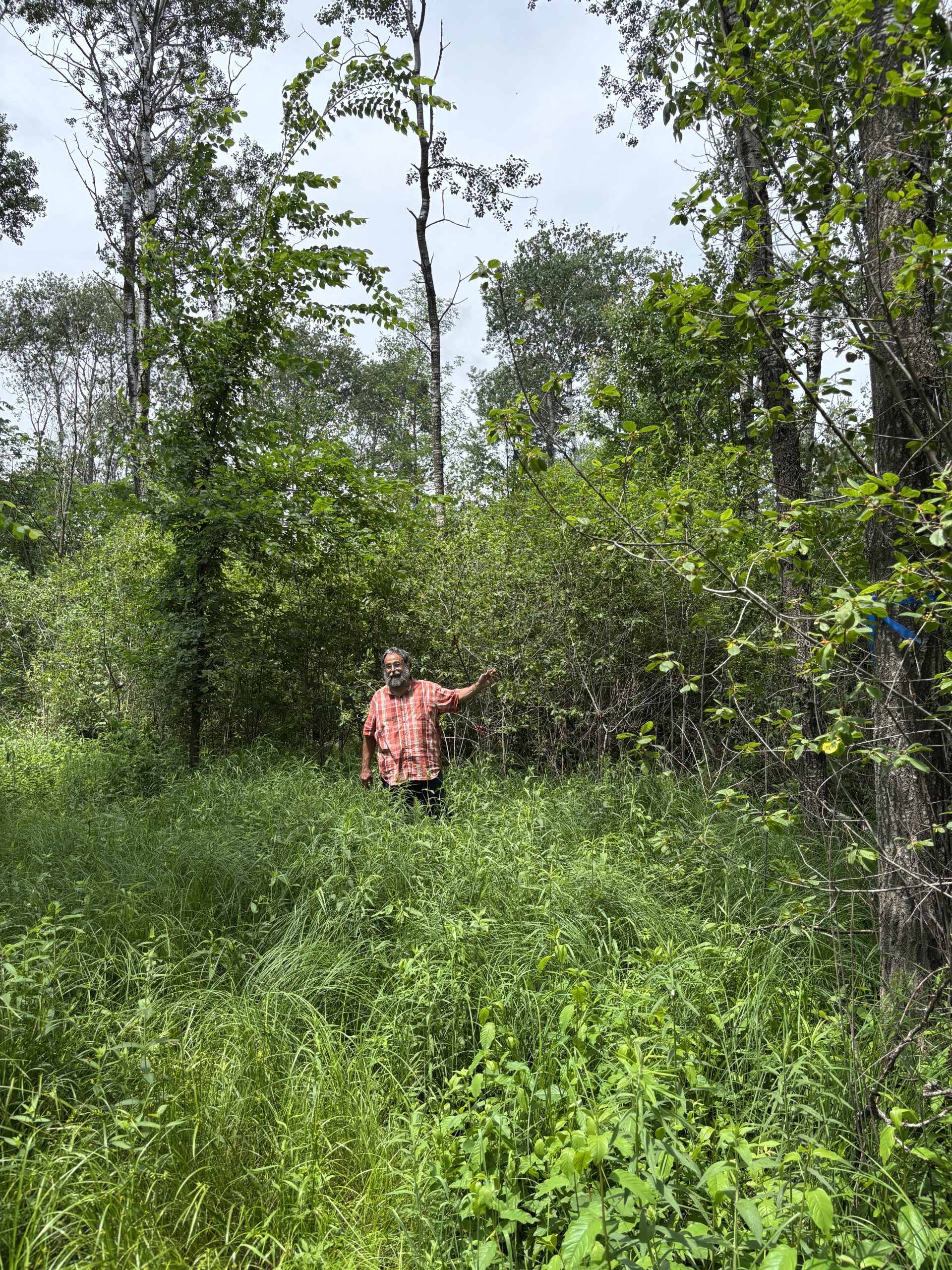
Learn more about…
Now that you know why invasive plants are a problem and how to identify them, let’s talk about how to manage them in your woods. Just like an effective coach of a sports team, you’ll need to be proactive about monitoring the lineup (the species present in your woods), adjust your coaching style based on how the game is going (choose management methods suited for the context), and develop a long-term strategy to prevent rogue players (invasive species) from derailing the team.
Dealing with invasive plants now will help your woods to continue providing recreation, timber harvesting, carbon storage, food, and wildlife benefits long into the future.
Jump to section
Prevention and monitoring
The best defense is a good offense, as they say! In the case of invasive plants, that means being vigilant to prevent their arrival in your woodland whenever possible.
Clean clothing and equipment
Whenever you move from one section of woods to another, make sure to clean your clothing, boots, pets, vehicle, and any equipment or machinery you’re bringing with you.
Clean boots by washing with soap and hot water and scrubbing with a stiff brush. Then use a screwdriver, hoof pick, butter knife, or tweezers to remove any remaining stuck material. Let your boots dry before storing.
Clean vehicles and heavy equipment before leaving the woods. Start with hand tools and a leaf blower. Back at home, use a hose to further clean off the equipment with water. Regularly check the cleaning area and remove any invasive plants that sprout. See more detailed instructions from the Minnesota DNR (PDF).
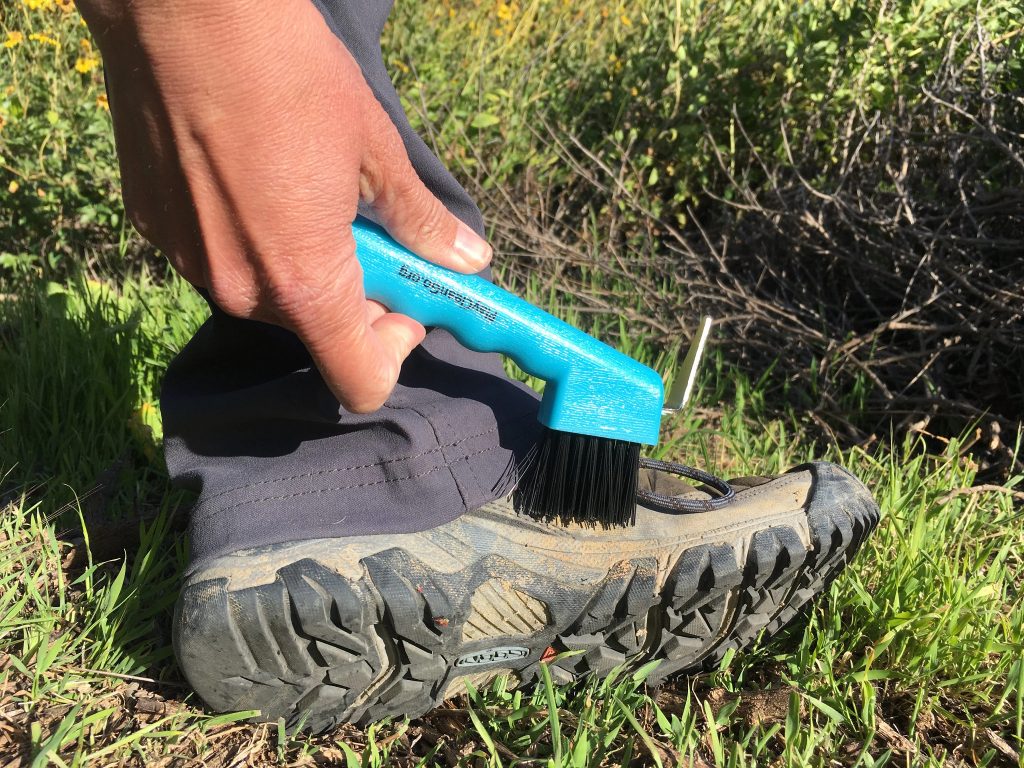
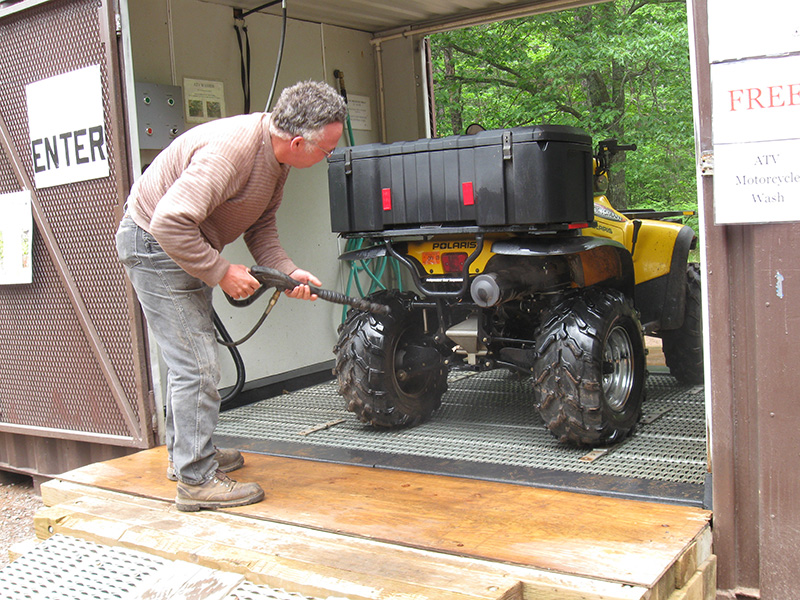
Monitor your woods and report new arrivals
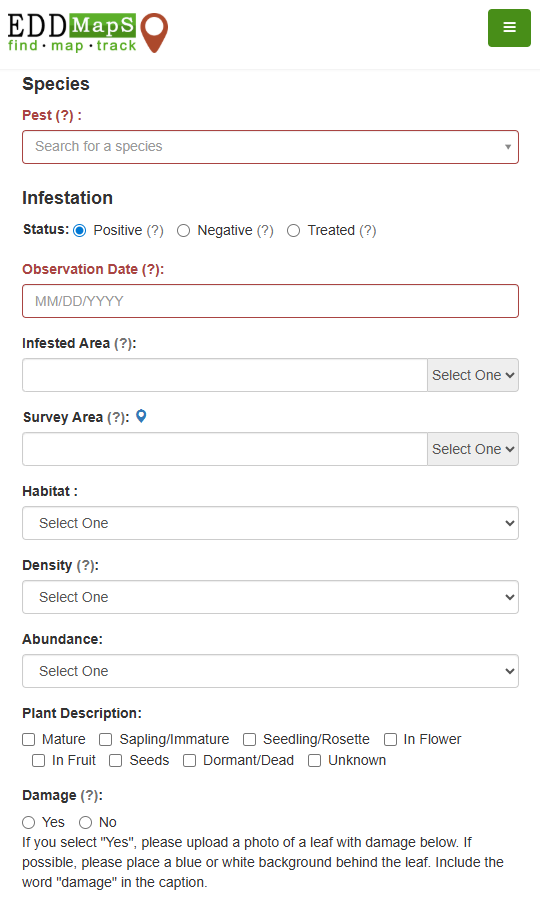
The more familiar you are with your woods, the sooner you’ll be able to spot an unwelcome arrival and the easier it will be to manage it. Since many invasive plants turn green earlier in the spring and stay green later in the fall than most native species, early spring and late fall are the best times to walk your woods to monitor for invasives. You can also take photos of your woods in every season to help yourself notice changes from previous years. And it’s always a good idea to talk with your neighbors to learn if they are seeing any new arrivals on their land that might be headed your way next.
If you do find an invasive species, check EDDMapS to find out how common or uncommon it is in Wisconsin. If it is not yet widespread in the state, please report it by following these steps:
- Take a variety of photos—close-up photos of leaves, flowers, fruits, and any other distinctive features, plus mid-range and zoomed-out photos of the landscape.
- Write down the location, habitat, size, and density of the infestation.
- Email Invasive.Species@Wisconsin.gov or forestry@extension.wisc.edu or submit an online report to EDDMapS.
Choose non-invasive plants
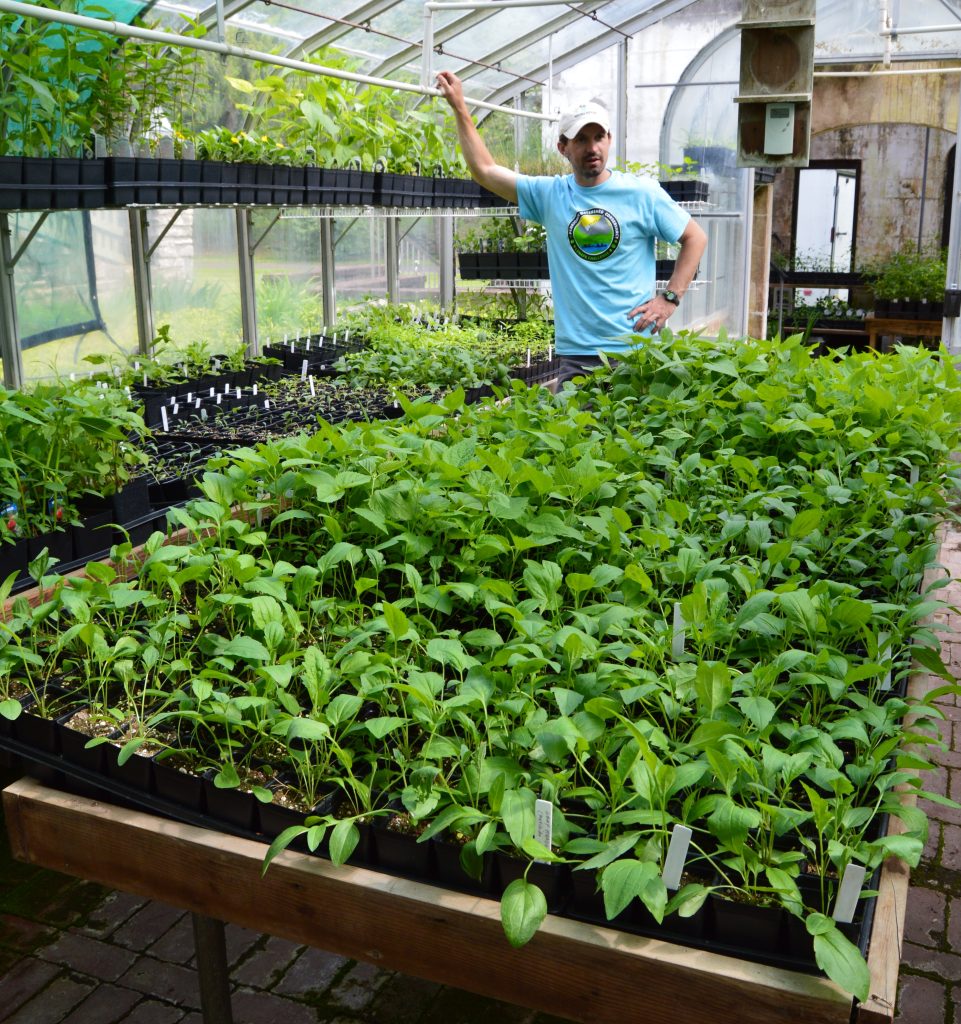
When you’re looking for trees, shrubs, or flowers to plant on your land or in your yard, choose native or other non-invasive species. Make sure to buy from a reputable seller—some “native” wildflower seed mixes contain problematic non-local plants like dame’s rocket.
Many local organizations (like nature centers, arboretums, “Friends of” groups, and Wild Ones chapters) host native plant sales in the spring. Ask your county land and water conservation department if they host a sale or know of a local group that does. The DNR also compiles a list of native plant sales each year. You can order native tree seedlings from DNR nurseries or private nurseries starting in the fall for delivery in the spring.
Common management methods
So you’ve found invasive plants growing in your woodland—what do you do now? Depending on the species, age, and surrounding vegetation, you have several options for removing undesired plants and suppressing their growth. For specific management recommendations for each plant, visit the UW-Madison Renz Weed Science Lab, the Midwest Invasive Plant Network, or the Woody Invasives of the Great Lakes Collaborative.
Hand pulling can be effective for annuals or biennials (plants that live only 1 or 2 years) that do not develop extensive root systems, as well as sometimes for young perennials or young woody plants. Remove as much of the root system as possible, using a hand tool like a weed wrench if needed. This method is best for isolated populations of annual or biennial plants like garlic mustard and dame’s rocket.
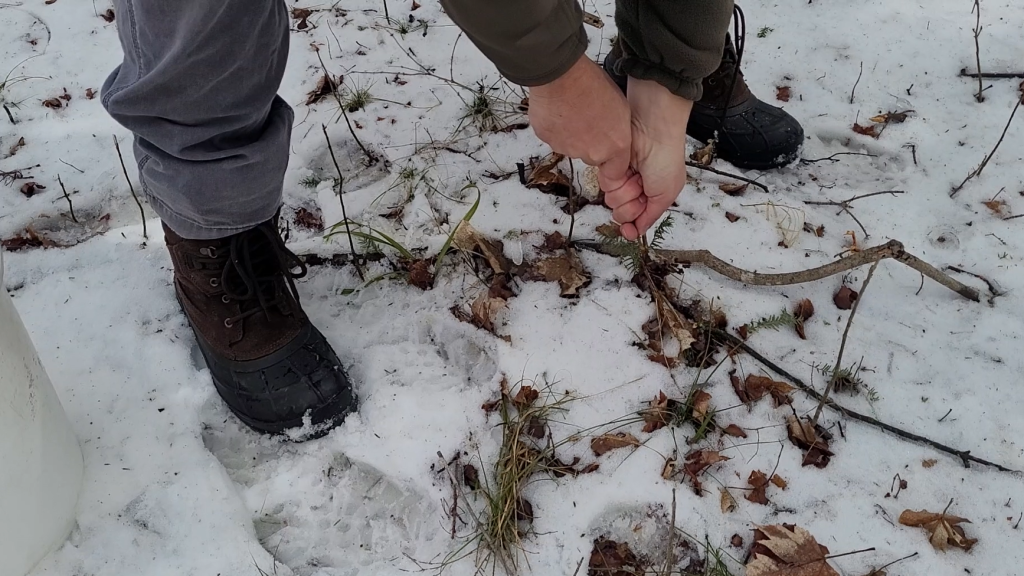
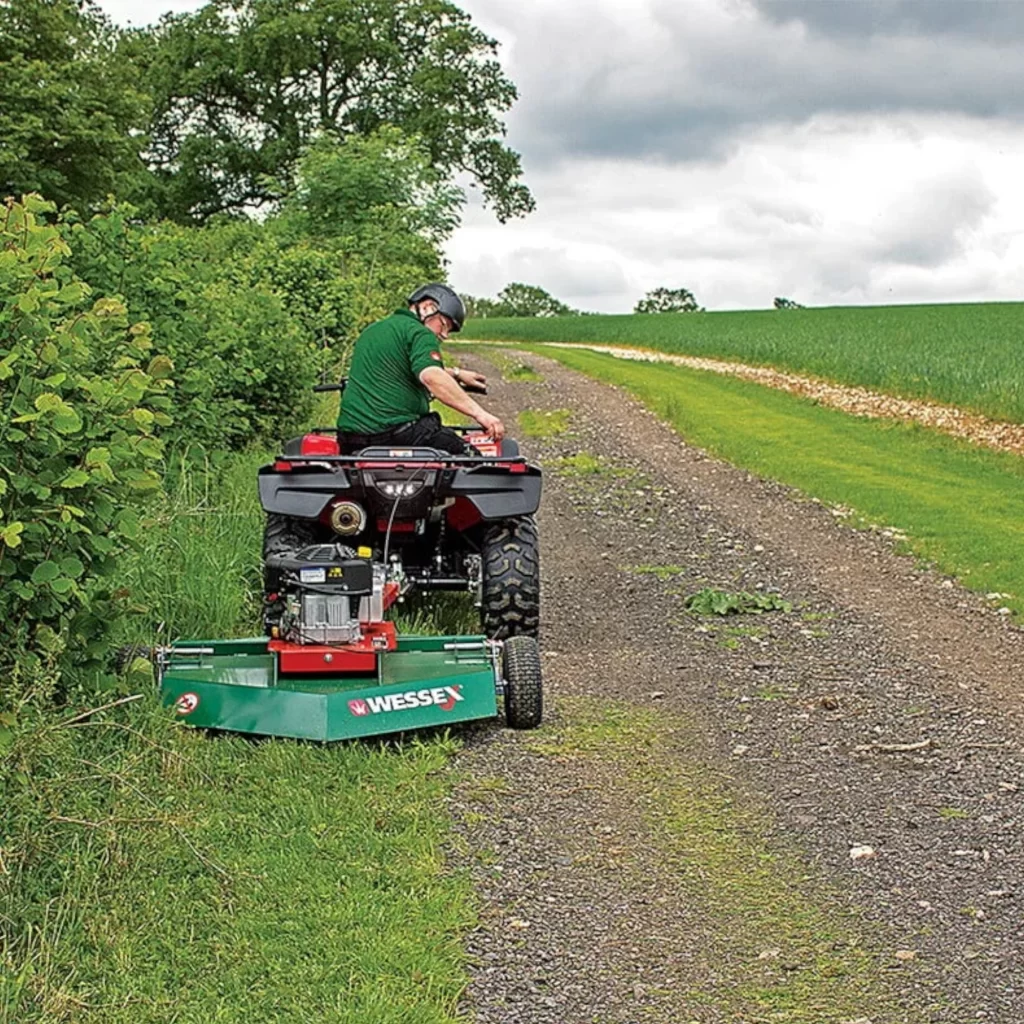
General mowing herbaceous plants just before flowering (or during early flowering) stops seed production but not root growth. It is especially effective for plants that reproduce only by seed. For plants that also reproduce by creeping roots, you’ll need to mow 3–4 times a year for multiple years. This method works well for large patches of garlic mustard or dame’s rocket.
Forestry mowing with large equipment can tackle woody plants, chewing up the stems into mulch. However, forestry mowing typically does not kill the root system of many woody plants. Following up with foliar and/or cut stump treatments (see below) after forestry mowing is often more effective than forestry mowing alone. Forestry mowing is typically used for big populations of common and glossy buckthorn or bush honeysuckles.
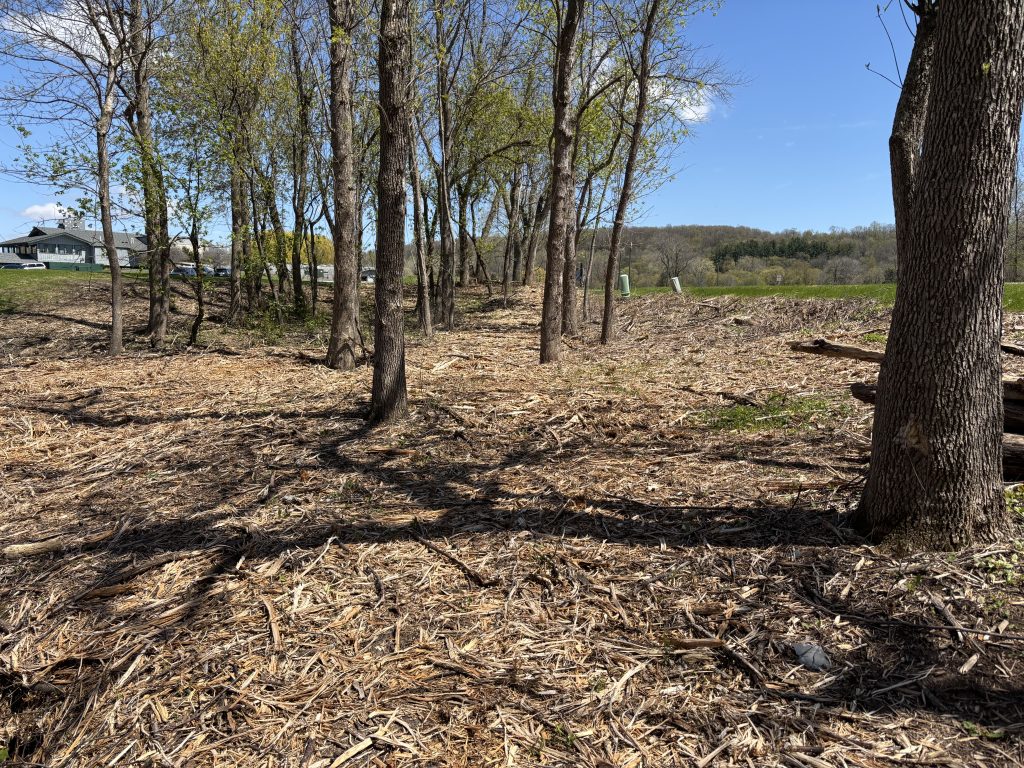
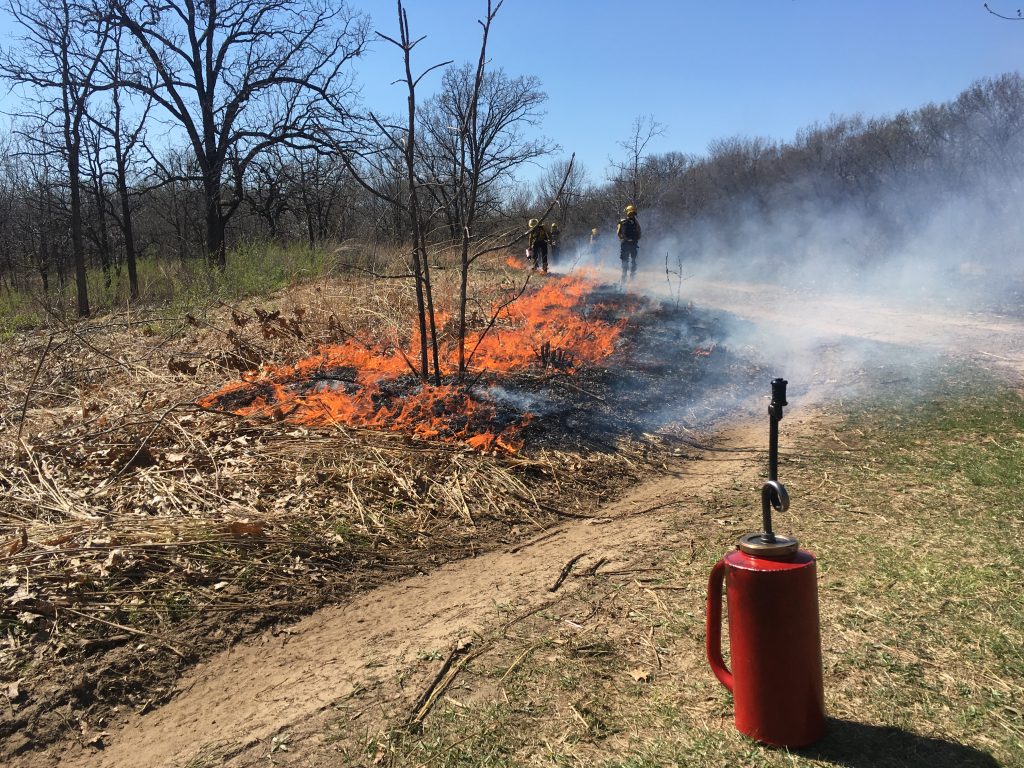
Prescribed fire in ecosystems that are adapted to fire (such as oak savannas and jack pine forests) can suppress invasive plants but does not often kill roots. Prescribed fire can allow native fire-adapted plants to outcompete suppressed invasive plants after the fire. Effectiveness depends on the intensity of the fire. This method can be used to manage common and glossy buckthorn, bush honeysuckles, and multiflora rose.
Foliar herbicide application involves coating the plants’ leaves with a dilute herbicide solution (enough that it runs off the leaves) during the growing season. This method works well for reed canary grass, phragmites, garlic mustard, round leaf bittersweet, and bush honeysuckles.
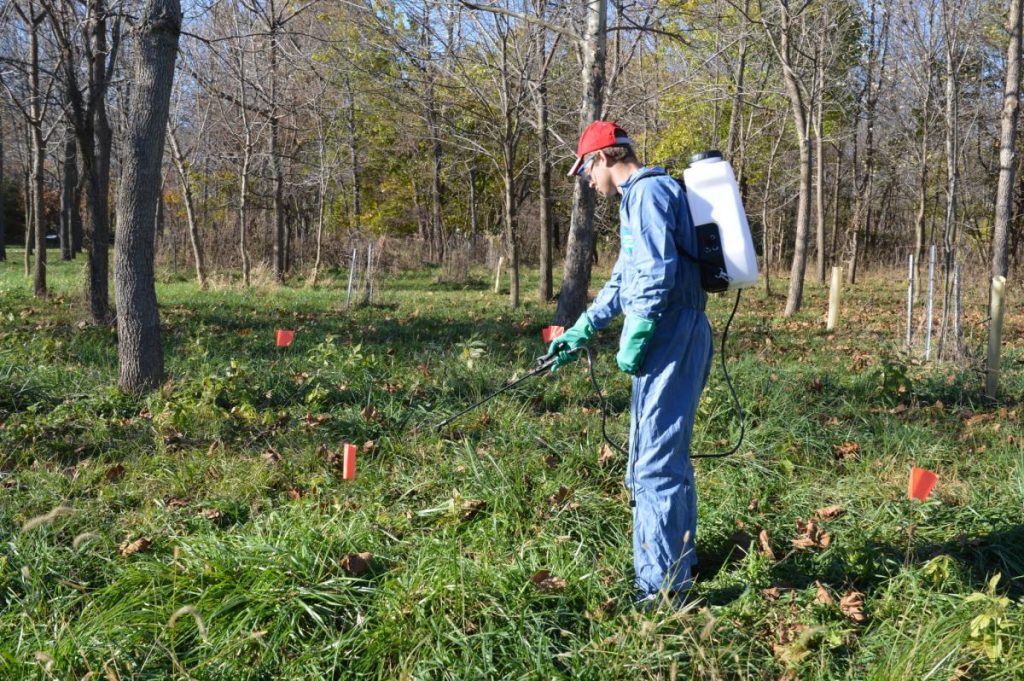
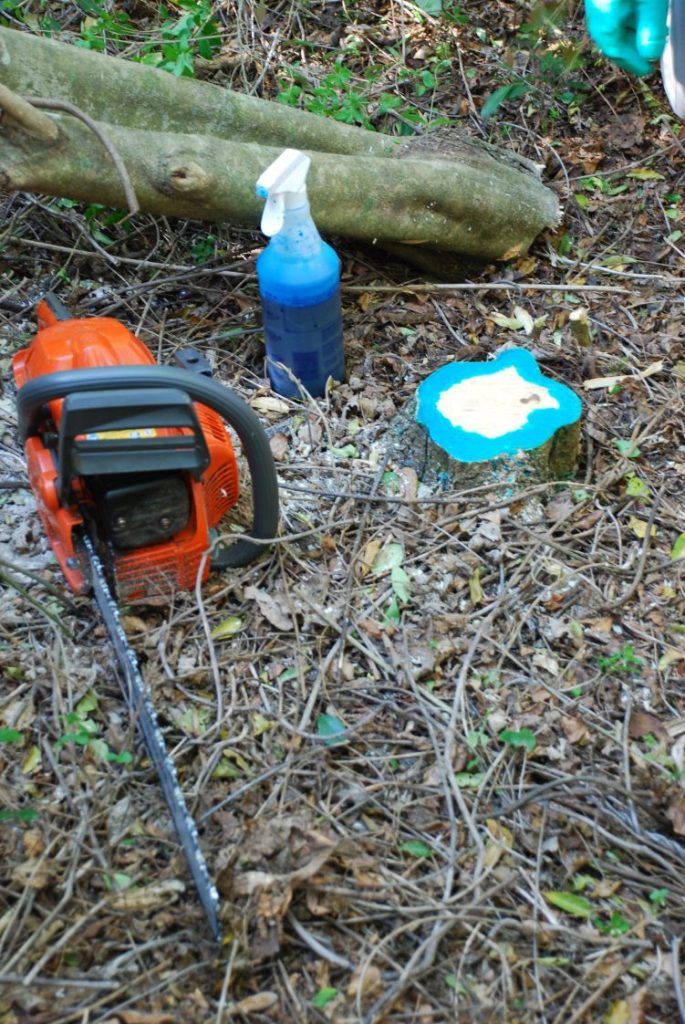
Cut stump treatments for woody plants involve cutting the plant near the ground and immediately applying a concentrated herbicide solution to the exposed stump. This method prevents the root system from regrowing, and it is commonly used for common and glossy buckthorn, bush honeysuckles, round leaf bittersweet, and black locust.
When using any herbicide, always read and follow the label instructions, which will state the application method, where you can apply it, the amount to mix, and whether other products need to be added. The label will also provide other important information, including what personal protective equipment to wear and how to avoid polluting the environment.
Different herbicides affect plants differently. Some (such as glyphosate products, commonly sold as Roundup) will damage any plant they touch. Others (such as triclopyr products, commonly sold as Garlon), can kill broadleaf plants but do not harm established grasses. Products applied to leaves or stems can be washed off by rain into the soil—some (such as imazapyr products) can persist for months to years after application and injure trees by being absorbed through roots.
Due to the complexity of using herbicides, we recommend getting trained. Extension has training manuals and classes on correct pesticide use in natural areas and forests. If you are considering using a restricted use herbicide, applying herbicides on property you don’t own, or applying herbicides in aquatic areas (such as a wetland or swamp), you may need a pesticide applicator license. In most other situations, you don’t need a license. Taking a training class and being careful to follow the label instructions will prepare you well for successful herbicide use.
It’s important to properly dispose of any invasive plants that you cut or pull. If there are any roots that could resprout, flowers, or fruits, seal the plants in heavy-duty plastic bags and place in sunlight for several weeks to sterilize seeds and kill roots. Only then can you throw them out with the rest of your trash. If there is no risk of regrowth, on-site disposal is generally ideal. Options include making a brush pile, chipping and mulching, burning, and more. Small-scale composting often does not sterilize seeds (but industrial-scale composing can).
Develop a management strategy
If you want to see long-term success, don’t just pick one technique and dive in. Instead, take the time to develop a management strategy, which will likely involve a combination of tactics over time.
- Map out the areas of infestation on your property. Take notes on the invasive plants’ location, size, and density, as well as the native plants in the same areas. You can even use smartphone applications such as EDDMapS, onX, Avenza, or Gaia GPS to to do this mapping.
- Read about the various management options available for the plants you’ll be dealing with and decide which combination is best suited for your situation.
- For the plant you’re dealing with, understand which seasons in the plant’s life cycle give you the best chance of success. For example, the best time to treat herbaceous invasive plants is often just before they flower or as they just start flowering.
- Using your invasive maps as a guide, decide whether you want to undertake the project yourself or hire a contractor.
- If you’ll do it yourself, make a list of the equipment you’ll need and write down target dates on your calendar for each step in the management process.
- Start your management efforts in areas of low infestation (areas where the invasives are not yet the dominant plants). Once you have some success there, you can work your way up to the areas of denser infestation.
As much as you may wish that invasive species management could be “one and done,” that is rarely the case. Instead, you’ll likely need to use a combination of methods over time. Each year, write down what you did and what the results were. Then adjust your plans for the next round of treatment accordingly.
As you start suppressing the growth of non-local plants, the next step is to actively encourage the growth of native plants. Seeding or planting native species soon after removing invasives will make it harder for the invasives to return.
Click the + below for an example outline of a plan to manage a small buckthorn infestation (less than half an acre).
Example buckthorn management plan
- The first year, remove as many plants as you can. Effective techniques include:
- Pull plants by hand or with tools.
- Cut the stem at the soil surface, then treat the stump with herbicide or cover it with a black plastic bag.
- If you can’t remove all the plants, focus on the fruit-producing plants in order to slow reproduction.
- Re-seed the area with wildrye grasses and wildflowers.
- The next year, finish removing existing adult buckthorn. Monitor for new buckthorn seedlings and hand-pull them, foliar treat them with herbicide, or use a propane torch.
- By the third year, you should have very few seedlings germinating. Continue treating any remaining buckthorn.
- Throughout the whole process, monitor uninfested areas to make sure a new infestation does not arrive. Clean your clothes, boots, and gear after each visit to this part of your woods, and ask any visitors to your land to arrive with clean clothes, boots, and gear.
For a larger buckthorn population, you’ll likely need to incorporate additional techniques over a longer period of time.
Team up with other woodland stewards
Plants and animals don’t know where your neighbor’s property ends and yours begins. So working together with other landowners and natural resource professionals to manage invasives is a great idea.
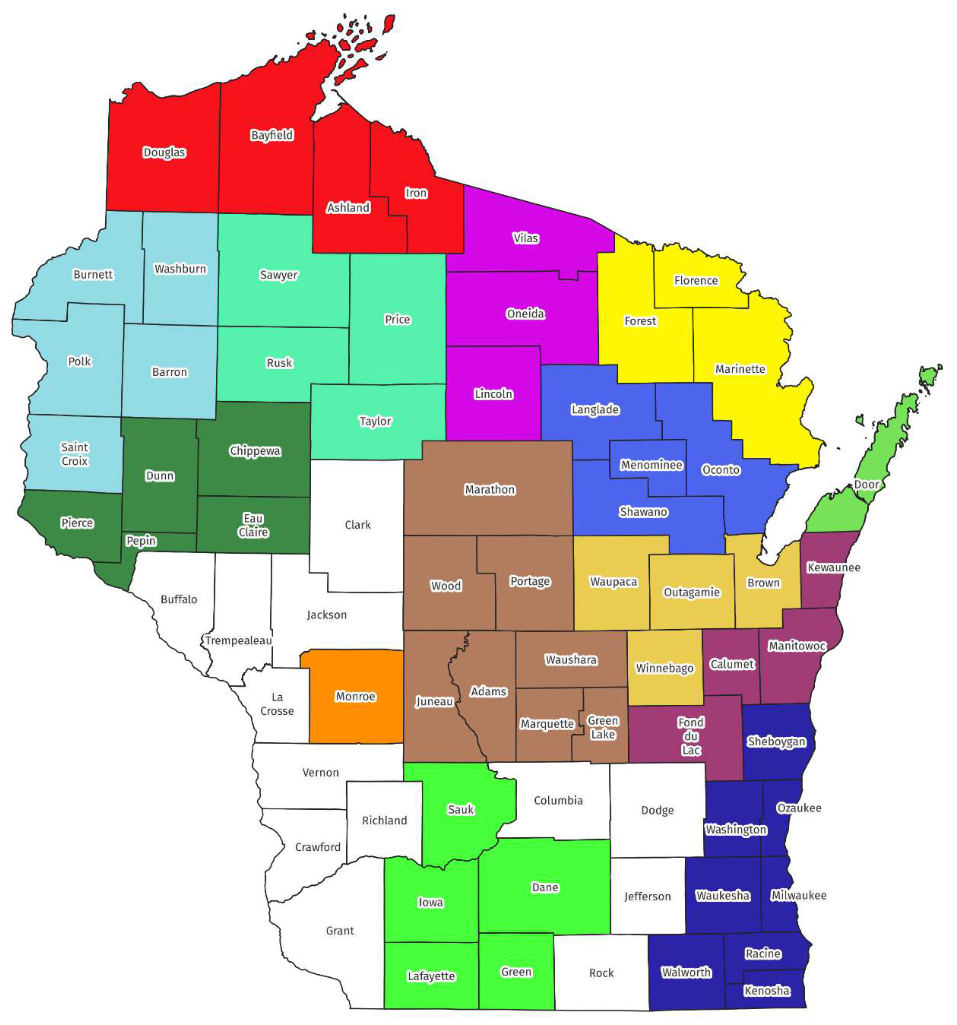
One way to do so is to connect with a Cooperative Invasive Species Management Area. CISMAs are regional partnerships among government agencies, tribes, landowners, and community organizations. They monitor and report invasives, coordinate management efforts, and raise awareness in the community. Some even have equipment that you can borrow. Currently, Wisconsin has 14 CISMAs, which cover a total of 59 out of the state’s 72 counties.
You may be able to get cost-share funding for managing invasive species. The Weed Management Area Private Forest Grant Program reimburses up to 75% of your costs. To apply for one of these grants, you can work with a CISMA or form your own “weed management group.” Another option is the Wisconsin Forest Landowner Grant Program, which reimburses up to 50% of your costs. Some federal programs, like the Environmental Quality Incentives Program through the Natural Resources Conservation Service, also offer landowners funding for invasives management. Read more about cost-share programs.
If you want to hire someone to do the boots-on-the-ground work, check out this list of restoration contractors* and watch our webinar about how to hire a natural resource professional.
We don’t want to sugarcoat it—managing invasive species takes a lot of time, labor, and energy. Most treatments will need routine follow-ups to slowly reduce populations over several years, and you’ll need to keep monitoring long-term. But your dedication and persistence will be worth it as you see your woodland fill with diverse wildflowers, shrubs, wildlife, and the next generation of trees!
*List provided for informational purposes only and does not represent Extension’s endorsement of any particular company.
Further Reading
- Invasive Plant Management Factsheets (UW–Madison Extension)
- Woody Invasives of the Great Lakes Collaborative (detailed guides for 11 management techniques)
- Invasive Plant Control Database (Midwest Invasive Plant Network) (multiple management options for many species)
- Overview of control methods (Wisconsin Department of Natural Resources)
- University of Wisconsin Pesticide Applicator Training
- Using Herbicide to Control Invasive Plants (UW–Madison Extension webinar, 2025)
- Winter Invasive Plant Management Techniques (UW–Madison Extension webinar, 2024)
- Taking Action After Getting a Forest Stewardship Plan: Hiring a Natural Resource Professional (UW–Madison Extension webinar, 2025)
- Manual, mechanical, and cultural control methods and tools (US Forest Service, 2011)
- How to Properly Dispose of Invasive Plant Species (Penn State Extension, 2024)
- Wisconsin’s Forestry Best Management Practices for Invasive Species (Wisconsin Council on Forestry, 2009) (PDF)
- Invasive Species Best Management Practices: Rights of Way (Wisconsin Council on Forestry) (provides suggested timing of mowing and other treatment for selected species in southern Wisconsin)
- Best Management Practices for Preventing the Spread of Invasive Species by Outdoor Recreation Activities in Wisconsin (Wisconsin Council on Forestry, 2007) (PDF)
- An Update on Invasive Plant Control (My Wisconsin Woods, 2024)
- Cover It Up Project (University of Minnesota) (guidance on using native plants to suppress buckthorn)
- Wisconsin Restoration Contractors (list compiled by Wisconsin Department of Natural Resources, 2025)
Keep learning about…
If you have questions about invasive plants and your woods or feedback on this webpage, contact:

Keith Phelps
Working Lands Forestry Educator
keith.phelps@wisc.edu
920-840-7504
Page last updated September 2025.
Additional photo credits:
- Man in greenhouse: Montgomery County Planning Commission, CC BY-SA 2.0
- ATV pull-behind mower: Good Works Tractor Company
- Foliar backpack spraying: Ohio State University Extension
- Cut-stump treatment: Alabama Cooperative Extension System